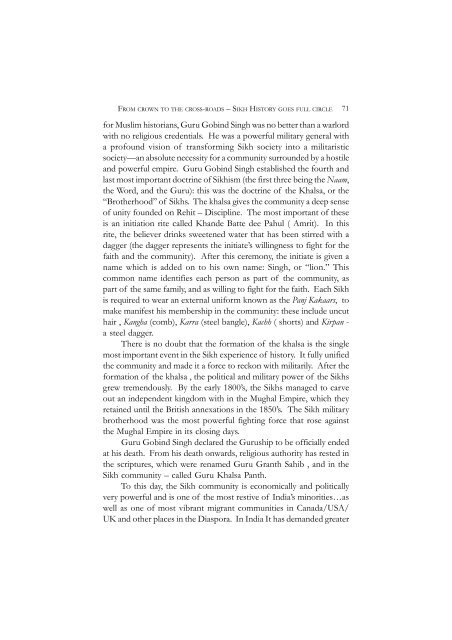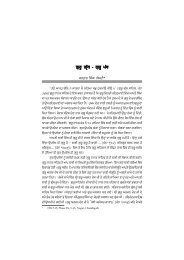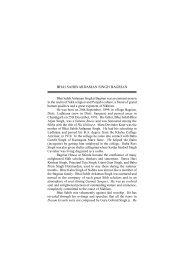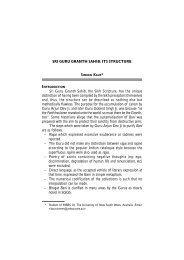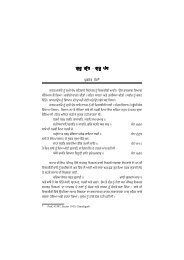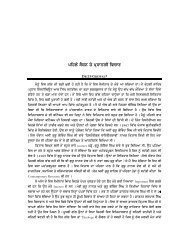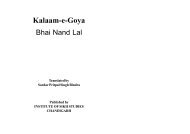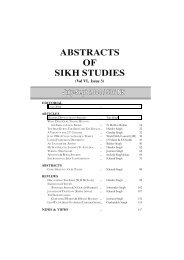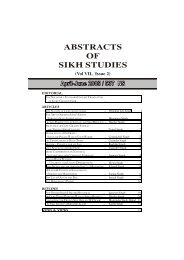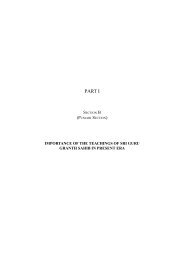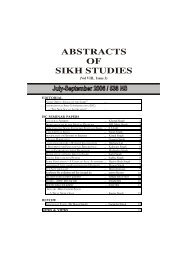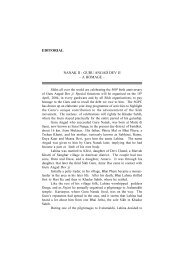Create successful ePaper yourself
Turn your PDF publications into a flip-book with our unique Google optimized e-Paper software.
FROM CROWN TO THE CROSS-ROADS – SIKH HISTORY GOES FULL CIRCLE71for Muslim historians, Guru Gobind Singh was no better than a warlordwith no religious credentials. He was a powerful military general witha pr<strong>of</strong>ound vision <strong>of</strong> transforming <strong>Sikh</strong> society into a militaristicsociety—an absolute necessity for a community surrounded by a hostileand powerful empire. Guru Gobind Singh established the fourth andlast most important doctrine <strong>of</strong> <strong>Sikh</strong>ism (the first three being the Naam,the Word, and the Guru): this was the doctrine <strong>of</strong> the Khalsa, or the“Brotherhood” <strong>of</strong> <strong>Sikh</strong>s. The khalsa gives the community a deep sense<strong>of</strong> unity founded on Rehit – Discipline. The most important <strong>of</strong> theseis an initiation rite called Khande Batte dee Pahul ( Amrit). In thisrite, the believer drinks sweetened water that has been stirred with adagger (the dagger represents the initiate’s willingness to fight for thefaith and the community). After this ceremony, the initiate is given aname which is added on to his own name: Singh, or “lion.” Thiscommon name identifies each person as part <strong>of</strong> the community, aspart <strong>of</strong> the same family, and as willing to fight for the faith. Each <strong>Sikh</strong>is required to wear an external uniform known as the Panj Kakaars, tomake manifest his membership in the community: these include uncuthair , Kangha (comb), Karra (steel bangle), Kachh ( shorts) and Kirpan -a steel dagger.There is no doubt that the formation <strong>of</strong> the khalsa is the singlemost important event in the <strong>Sikh</strong> experience <strong>of</strong> history. It fully unifiedthe community and made it a force to reckon with militarily. After theformation <strong>of</strong> the khalsa , the political and military power <strong>of</strong> the <strong>Sikh</strong>sgrew tremendously. By the early 1800’s, the <strong>Sikh</strong>s managed to carveout an independent kingdom with in the Mughal Empire, which theyretained until the British annexations in the 1850’s. The <strong>Sikh</strong> militarybrotherhood was the most powerful fighting force that rose againstthe Mughal Empire in its closing days.Guru Gobind Singh declared the Guruship to be <strong>of</strong>ficially endedat his death. From his death onwards, religious authority has rested inthe scriptures, which were renamed Guru Granth Sahib , and in the<strong>Sikh</strong> community – called Guru Khalsa Panth.To this day, the <strong>Sikh</strong> community is economically and politicallyvery powerful and is one <strong>of</strong> the most restive <strong>of</strong> India’s minorities…aswell as one <strong>of</strong> most vibrant migrant communities in Canada/USA/UK and other places in the Diaspora. In India It has demanded greater


